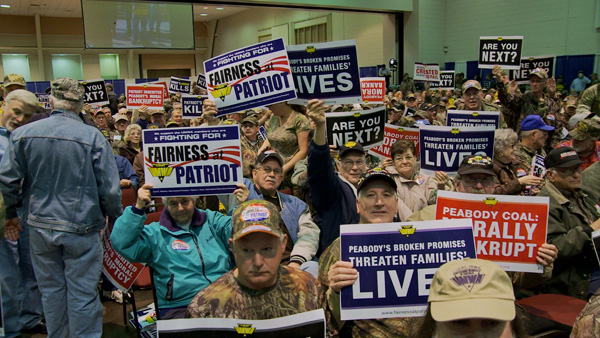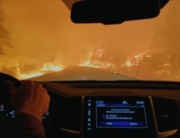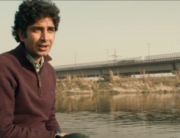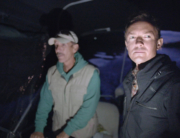Blood on the Mountain buries the lead about the relationship between the residents of Appalachia and the coal in their ground. Directors Mari-Lynn Evans and Jordan Freeman are very familiar with the people and resources in their region from their earlier TV documentaries (Coal Country), and it’s too bad that they think audiences still need to know the whole 150-year history of miners, mining companies, and government regulation before revealing how the people of West Virginia support policies and lifestyles that go against their long-term health and environmental and economic futures.
The well-known conflict, miners vs. mining companies, has loomed large in American history and popular culture. In the movies, the 19th-century standoff is epitomized by Martin Ritt’s The Molly Maguires (1970), the early 20th century by John Sayles’s Matewan (1987), and the later in Barbara Kopple’s documentary Harlan County U.S.A., a restoration of which just debuted at the New York Film Festival. Descriptive songs have entered American folklore about the tough work of mining (think “16 Tons”), and labor songs are synonymous with union organizing, such as “Which Side Are You On?” (referenced here ironically). The recent PBS American Experience episode “Mine Wars” well covered the fight for union recognition up through the New Deal, which brought about the acceptance of the United Mine Workers of America in 1933.
Blood on the Mountain, in great detail, follows up on what happened to any hope for happy ever after. It can pretty much be summed up by one cause, corruption—in the union and among high-level elected officials (there’s a head-spinning, chronological chain of bribery convictions). The only politicians shown railing against the companies for more regulation are Democrats no longer in office—the late Senator Robert Byrd and former Governor/Senator Jay Rockefeller.
There’s a tearful telling of fatal mine accidents and how each one was followed by failed or weak attempts at more regulation that resulted in only minor safety adjustments. Former inspectors describe the corporate and community threats and pressures to ignore violations, and miners detail how inspections were cheated anyway. (The U.S. Department of Labor’s Mine Safety and Health Administration reports annual deaths in the triple figures through the early 1980s, figures that are reduced as the number of miners is now half as many.) In addition to grieving family members, there are interviews with ex-miners who suffer from injuries and diseases, particularly “black lung,” and their bitter survivors.
One major villain isn’t fully dealt with until halfway through: Massey Energy, particularly as run by local boy CEO Don Blankenship from 2000 to 2010, during which the infamous Upper Big Branch Mine disaster cost 29 lives and his job. He’s currently serving a year’s sentence in jail for conspiring to commit safety violations. (He has just issued a letter from jail protesting that he’s really an “American political prisoner.”) Journalist Peter A. Galuszka, author of Thunder on the Mountain: Death at Massey and the Dirty Secrets Behind Big Coal (2012), credits Blankenship for most effectively turning the “us” against “them” mentality of West Virginians from the traditional “companies” vs. “labor” into an extension of the political culture wars. So “we” are now “coal country,” and “they” are “hippies” (they still use that term), environmentalists, and climate change activists who want to take away “our” jobs and businesses.
The coal companies are shown to support organizations like Friends of Coal Ladies Auxiliaries and Partners in Education school programs that sound like the pro-nuclear energy PR that The Simpsons satirizes. Blankenship and the industry’s attitude are remarkably caught in footage from his Labor Day 2009 “Friends of America” rally with Sean Hannity, Hank Williams Jr., and Ted Nugent, which he emcees in a star-spangled flag outfit. Blankenship whips up the crowd by making clear what he means when he asks them to choose “Which Side Are You On?” to raucous cheers of approval. (The state has voted for Republican presidential candidates since 2000.)
The documentary quickly moves on to other issues of environmental damage and lower employment—the first issue being mountaintop removal. The physical destruction and pollution was already showcased in Bill Haney’s The Last Mountain (2011), which featured environmental attorney Robert F. Kennedy Jr. (Galuszka dismisses that film for coming from an outsider).
Then on to water pollution, particularly the Elk River contamination of 2014, where almost half a million people lost drinkable water for weeks, including in the state capital of Charleston. West Virginia Governor Earl Ray Tomblin, a Democrat, carefully makes excuses at a press conference: “This was not a coal company incident. This was a chemical company incident,” (though the chemical was a coal-washing agent).
With almost two dozen Appalachian interviewees (only journalist Chris Hedges is widely known nationally), the directors unconvincingly try to establish that there is a growing constituency for a change in the relationship between King Coal and West Virginians to protect health and the environment. But I was left with the much more powerful impression from the TV news of rallies this election season of people, still “Friends of America,” who are vociferously willing to keep voting against their own best interests to hang on to whatever traditional mining jobs can be retained.

















Leave A Comment